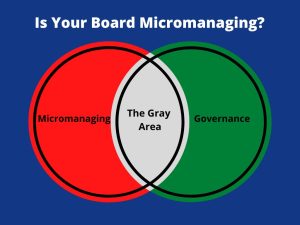
How to Stop Your Nonprofit Board from Micromanaging
A board member offers a suggestion. Then another. Before you know it, they’re directing staff, questioning decisions, and stepping into day-to-day operations. What started as helpful input has turned into full-blown micromanagement—derailing your strategy and frustrating your team.
Micromanagement harms nonprofits. Entities trying to focus on too many goals often go in circles. Board members may not intend to hurt the organization by micromanaging, but it happens.
Signs of board micromanagement include:- Focus on minor details, ignoring your strategy.
- Excessive monitoring of staff, lowering morale.
- Determining task methods, limiting creativity.
- Undermining CEO by direct task assignment.
- Questioning decisions, leading to delays.
(Unsure if your board is micromanaging or not? Take this quiz.)
Micromanagement Prevention
What can you do to eradicate and prevent the board’s micromanaging habits? How can you get them to focus on governance Here are four answers to adopt today.
1. Stop Micromanaging Boards with Role Clarity
- Authority during meetings
- Individual authority
As part of their onboarding, review roles. They will understand the logic of staff needing one set of guidelines, not one from every board member. (Too many cooks spoil the broth.) Ask them for advice: “How would you like to be reminded if you forget you’re acting without your other board members?
2. Stop Micromanaging Boards by Focusing Only on Governance
Understanding when board members act as a board is one type of role clarity that everyone needs. The second way to stop your board from micromanaging involves meeting behaviors. Your board chair opens the discussion about an agenda item, and the conversation drifts into what the staff should do and how they should do it.
Or, more commonly, the board stays in their governance lane, except for pet projects, new activity, or significant expenditures.
The best way to avoid this overreach is prevention.
For example, pull open our last meeting agenda. What items are listed? Where are the management decisions? Or policy and strategy questions? Label each item. How did you do? Many nonprofit leaders are embarrassed when they realize they invite micromanaging. It’s a standard error.
You can quickly correct this by planning what you will ask and working with committee chairs to frame their reports to the board. They share and update, and strategy-related questions decided in advance.
But what if you do this, and your board members still insist on micromanaging your decisions? Ideally, you have a board chair or board champion with whom you can honestly talk.
With this person, you can discuss the chaos and frustration caused by the board’s behavior. You can also share the guidance you need from the board to succeed and work together to steer the board.
3. Stop Micromanaging Boards by Recognizing Your Fear
Lack of role clarity is the most common reason we assign for board micromanagement. Just as often, an unnamed fear causes it.
Poor role clarity leads to issues in board operations. Knowing roles reduces micromanagement, but persistent issues suggest deeper problems
Anxiety can be about current problems, something that happened in the past, or something that happened to another organization making headlines.
A Fear Example
Let’s step into one of your board member’s heads for a minute.
You’ve been a board member for a year. You attended an orientation. You learn more about the organization at board and committee meetings. During today’s board meeting, the chair announced that the organization needs its client confidentiality upgraded and must allocate 10 percent of the budget for a HIPPA compliance system.
Everyone is upset. While this board member knows that the board’s role is to govern, he steers the discussion from governance to a microsecond.
Unknown to you, the member has never made this big a financial decision. Economic choices freak them out. Controlling the details soothes the anxiety.
Fear can be collective or individual, but it’s often contagious.
The best way to tame the fear is to name it. Once named, you can guide the board to establish policies that allow staff to reduce the risks and put fears at bay.
4. Stop Micromanaging Boards by Asking What Scares You
The final way to stop your board from micromanaging involves asking about your leadership. When it comes to micromanaging, this is scary. Instead of worrying, ask. Request a performance appraisal. Are you delivering on the board’s expectations? If your board has lost faith in your leadership abilities, it’s best to know it. If your fears are ungrounded, you’re in an ideal place to improve your board and move towards being a governance board. Start by sharing that the board has been a wonderful asset to your nonprofit. “Now, that we’ve gotten our feet on the ground, we have an opportunity to elevate the conversations, so your service will have so an even greater impact.” Big picture: Educate board members at every step of their lifecycle. Share the board’s role with prospects, recruits, and members for policy and strategy work. If you fail to guide your board, they’ll assume you seek micromanaging. After all, setting policies and establishing strategies is hard work. Armchair managing is easier than creating policies. Moreover, most people have more experience managing than governing.Stop Micromanaging Boards by Thriving in the Tension
Robert Frost’s words, “Good fences make good neighbors,” inspired this post. Twice in Frost’s poem Mending Wall, a neighbor says, “Good fences make good neighbors.”
The poem epitomizes the need to keep your board focused on their work so you can do your work. When your board focuses on determining your strategy and establishing policies, your board leverages everyone’s efforts.
Mend your staff-board tasks boundary breaches. You can stop your board’s micromanaging habit.
Has your board ever micromanaged you? How did you address it? Share your experiences and tips here. We all learn from other’s experiences.
Resources in this Series
Check out the other posts in this series:
Quiz: Is Your Board Micromanaging? Find Out Now!– Engage with a self-assessment tool.
Why Does Your Nonprofit Board Micromanage? Is It You?– Understand the underlying causes of board micromanagement.
Lead More: How to Curb Your Board’s Micromanaging Habit– Get strategic advice on redirecting board behavior.
Karen Eber Davis is a nonprofit strategic planning consultant who works with visionary leaders committed to taking their organizations to new heights. She offers customized strategies, assessments, and coaching designed to help leaders lead their organizations to achieve their potential. She is the author of 7 Nonprofit Income Streams and Let's Raise Nonprofit Millions Together.
Categories
If you appreciate these Added Value posts, please consider subscribing.
Latest Posts
- How New Nonprofit CEOs Secure Board Buy-In for Strategic Planning
- How Nonprofit Leader Navigate Crisis with Clarity & Confidence
- One Way AI Can Help You Find a Path Where None Exists
- In Crisis? Resist Cutting Your Ability to Make Income
- Nonprofit Strategic Planning Assessment: 10 Questions About Your Strategy

